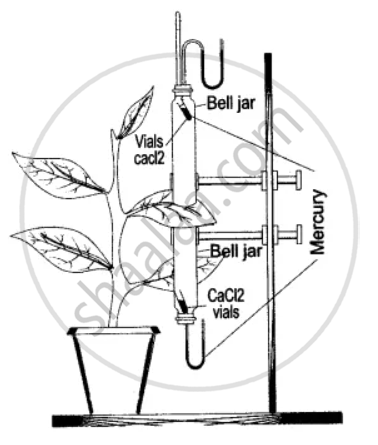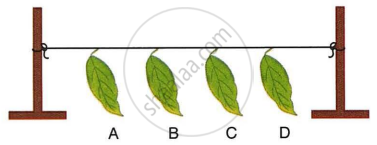Advertisements
Advertisements
प्रश्न
Given below is an experimental set up to study a particular process:

(i) Name the process being studied.
(ii) Explain the process named in (i) above.
(iii) Why is the pot covered with a plastic sheet?
(iv) Mention one way in which this process is beneficial to the plant.
(v) Suggest a suitable control for this experiment.
उत्तर
(i) Transpiration.
(ii) It is processed in which water in the form of vapours are released from the aerial parts like leaves and soft stems of the plant.
(iii) The plastic sheet will not allow the moisture of the mud of the pot to come out and affect the result.
(iv) It helps in the ascent of sap in the plant.
(v) A similar apparatus is set up without the potted plant. In its place, the same plastic bag, with its mouth tied, is kept in the bell jar. No water drops will appear in the bell jar.
APPEARS IN
संबंधित प्रश्न
Name the following:
Any two parts of a leaf which allow transpiration.
The apparatus shown here is Girreau’s poto-meter designed to demonstrate unequal transpiration from the two surfaces of a dorsiventral leaf. Before keeping the leaf in between the cups, anhydrous calcium chloride (CaCl2) contained in two small vials were weighed and placed in both the cups. The ends of the cups were closed with corks through which two mercury manometers were connected. After a few hours, CaCl2 vials were taken out and weighed again.
(i) What is the purpose of keeping CaCl2 vials inside the cup?
(ii) After a few hours, the CaCl2 vials were taken out and weighed again. Will you expect any difference in weight? If so, give reasons.
(iii) What was the purpose of using a mano-meter?
(iv) What do you mean by transpiration?
Draw a labeled diagram of the stomatal apparatus and label the following in it: Stoma, Guard cells, Chloroplast, Epidermal cells, and Cell wall.
Mark the most appropriate answer in the following:
In the mechanism of opening and closing of stomata, the important factor is
Suppose you have a rose plant growing in a pot, how will you demonstrate transpiration in it?
Name the following:
The openings on the barks of trees through which transpiration occurs.
Give a reason/suitable explanation.
More transpiration occurs from the under surface of a dicot leaf.
The given figure represents an experiment:

- Leaf A was coated with grease on both surfaces.
- Leaf B was coated with grease on the lower surface.
- Leaf C was coated with grease on the upper surface.
- Leaf D was left without any application of grease. All four leaves A, B, C and D were left in a room for about 24 hours.
- Which leaf dries first? Give reason.
- Which leaf dries last? Give reason.
